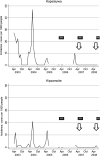Decreased prevalence of anemia in highland areas of low malaria transmission after a 1-year interruption of transmission
- PMID: 22052892
- PMCID: PMC3245725
- DOI: 10.1093/cid/cir768
Decreased prevalence of anemia in highland areas of low malaria transmission after a 1-year interruption of transmission
Abstract
Background: Malaria control campaigns have reduced malaria transmission to very low levels in many areas of Africa. Yet the extent to which malaria interruption or elimination might decrease the prevalence of anemia in areas of low malaria transmission is unknown.
Methods: Kapsisiywa and Kipsamoite, highland areas of Kenya with low, unstable malaria transmission, experienced a 12-month interruption in malaria transmission from April 2007 to May 2008, following high-level coverage (>70% of households) with indoor residual insecticide spraying in 2007. Hemoglobin levels were tested in 1697 randomly selected asymptomatic residents of Kapsisiywa (n = 910) and Kipsamoite (n = 787) at the beginning of a 12-month period of interrupted transmission (in May 2007) and 14 months later (in July 2008).
Results: From May 2007 to July 2008, only 1 of 1697 study cohort members developed clinical malaria. In this period, the prevalence of anemia decreased in Kapsisiywa in all age groups (from 57.5% to 37.9% in children aged <5 years [P < .001], from 21.7% to 10.5% in children aged 5-14 years [P < .001], and from 22.7% to 16.6% in individuals aged ≥ 15 years [P = .004]). The prevalence of anemia in Kipsamoite also decreased in children aged <5 years (from 47.2% to 31.3%; P = .001) but was unchanged in children aged 5-14 years and in individuals aged ≥15 years. Among children <5 years, anemia prevalence was reduced by 34% in both Kapsisiywa (95% confidence interval [CI], 21%-45%) and Kipsamoite (95% CI, 16%-48%).
Conclusions: Successful malaria elimination or interruption may lead to substantial reductions in anemia prevalence even in areas of very low transmission.
Figures

Similar articles
-
Decline in childhood iron deficiency after interruption of malaria transmission in highland Kenya.Am J Clin Nutr. 2014 Sep;100(3):968-73. doi: 10.3945/ajcn.114.087114. Epub 2014 Jul 30. Am J Clin Nutr. 2014. PMID: 25080460 Free PMC article.
-
Possible interruption of malaria transmission, highland Kenya, 2007-2008.Emerg Infect Dis. 2009 Dec;15(12):1917-24. doi: 10.3201/eid1512.090627. Emerg Infect Dis. 2009. PMID: 19961670 Free PMC article.
-
The Effect of Indoor Residual Spraying on the Prevalence of Malaria Parasite Infection, Clinical Malaria and Anemia in an Area of Perennial Transmission and Moderate Coverage of Insecticide Treated Nets in Western Kenya.PLoS One. 2016 Jan 5;11(1):e0145282. doi: 10.1371/journal.pone.0145282. eCollection 2016. PLoS One. 2016. PMID: 26731524 Free PMC article.
-
Development of clinical immunity to malaria in highland areas of low and unstable transmission.Am J Trop Med Hyg. 2012 Nov;87(5):806-12. doi: 10.4269/ajtmh.2012.11-0530. Epub 2012 Sep 17. Am J Trop Med Hyg. 2012. PMID: 22987652 Free PMC article.
-
Lack of Consistent Malaria Incidence Hotspots in a Highland Kenyan Area During a 10-Year Period of Very Low and Unstable Transmission.Am J Trop Med Hyg. 2020 Dec;103(6):2198-2207. doi: 10.4269/ajtmh.19-0821. Epub 2020 Oct 27. Am J Trop Med Hyg. 2020. PMID: 33124534 Free PMC article.
Cited by
-
Joint modelling of malaria and anaemia in children less than five years of age in Malawi.Heliyon. 2021 May 4;7(5):e06899. doi: 10.1016/j.heliyon.2021.e06899. eCollection 2021 May. Heliyon. 2021. PMID: 34027150 Free PMC article.
-
Determining the risk factors of malaria and anemia in children between 6 and 59 months using the joint generalized linear mixed model on the 2021 Nigeria Malaria Indicator Survey dataset.Front Public Health. 2025 Jan 6;12:1503884. doi: 10.3389/fpubh.2024.1503884. eCollection 2024. Front Public Health. 2025. PMID: 39835311 Free PMC article.
-
Changes in antigen-specific cytokine and chemokine responses to Plasmodium falciparum antigens in a highland area of Kenya after a prolonged absence of malaria exposure.Infect Immun. 2014 Sep;82(9):3775-82. doi: 10.1128/IAI.01924-14. Epub 2014 Jun 23. Infect Immun. 2014. PMID: 24958707 Free PMC article.
-
Chronic infections with viruses or parasites: breaking bad to make good.Immunology. 2017 Apr;150(4):389-396. doi: 10.1111/imm.12703. Epub 2017 Jan 19. Immunology. 2017. PMID: 28009488 Free PMC article. Review.
-
Interferon-γ responses to Plasmodium falciparum vaccine candidate antigens decrease in the absence of malaria transmission.PeerJ. 2017 Jan 10;5:e2855. doi: 10.7717/peerj.2855. eCollection 2017. PeerJ. 2017. PMID: 28097063 Free PMC article.
References
-
- World Health Organization (WHO) Worldwide prevalence of anaemia 1993–2005: WHO global database on anaemia. Geneva, Switzerland: World Health Organization; 2008.
-
- Brabin BJ, Premji Z, Verhoeff F. An analysis of anemia and child mortality. J Nutr. 2001;131(2Suppl 2):636S–45S. discussion 646S-48S. - PubMed
-
- Brabin BJ, Hakimi M, Pelletier D. An analysis of anemia and pregnancy-related maternal mortality. J Nutr. 2001;131(2Suppl 2):604S–14S. discussion 614S-15S. - PubMed
-
- Grantham-McGregor S, Ani C. A review of studies on the effect of iron deficiency on cognitive development in children. J Nutr. 2001;131(2Suppl 2):649S–66S. discussion 666S-68S. - PubMed
-
- Menendez C, Kahigwa E, Hirt R, et al. Randomised placebo-controlled trial of iron supplementation and malaria chemoprophylaxis for prevention of severe anaemia and malaria in Tanzanian infants. Lancet. 1997;350:844–50. - PubMed
Publication types
MeSH terms
Substances
Grants and funding
LinkOut - more resources
Full Text Sources
Medical
Miscellaneous

